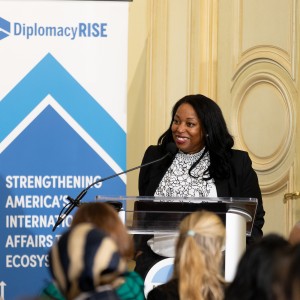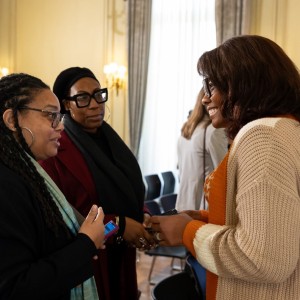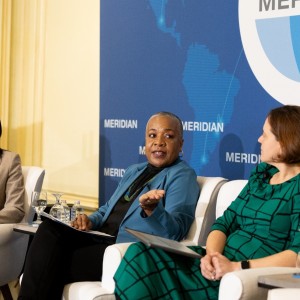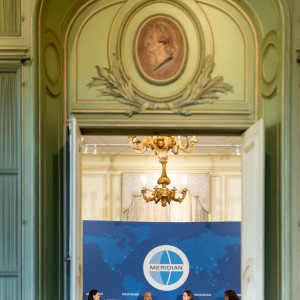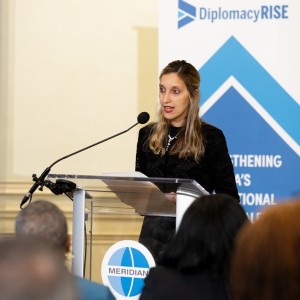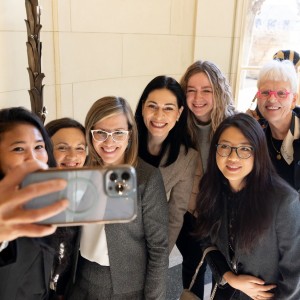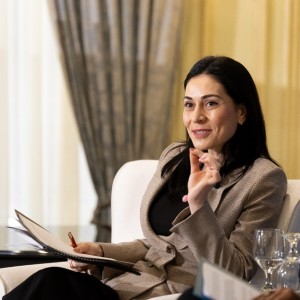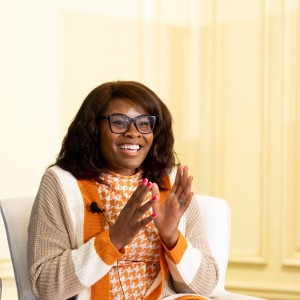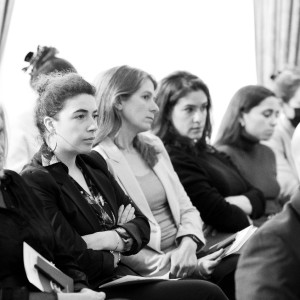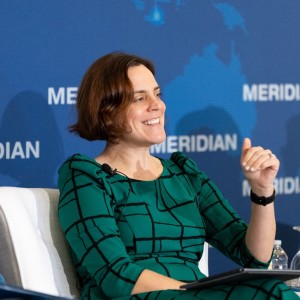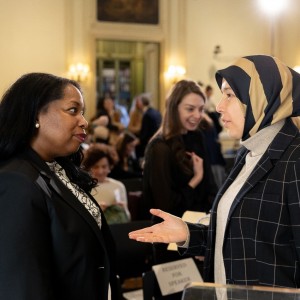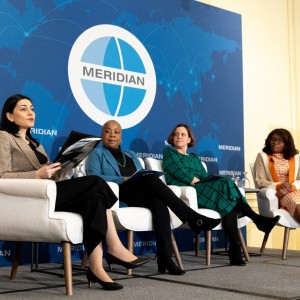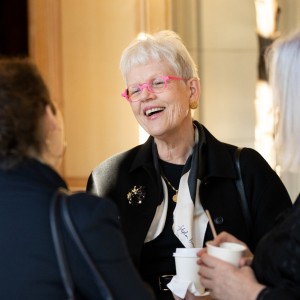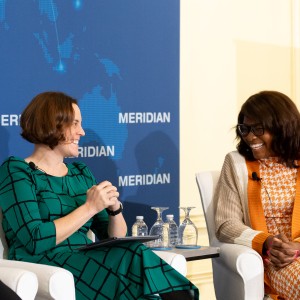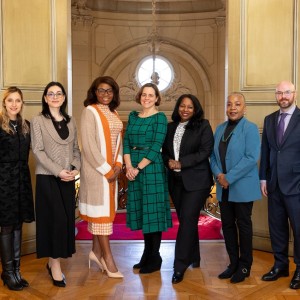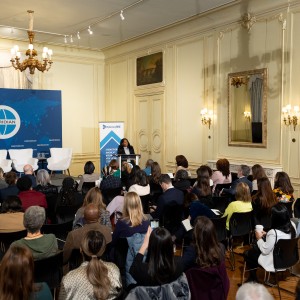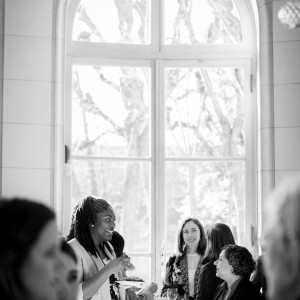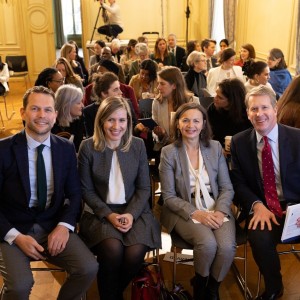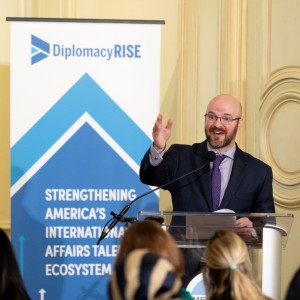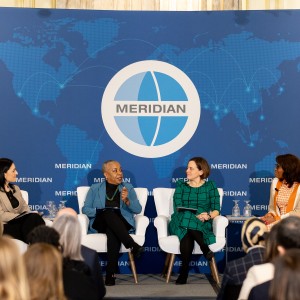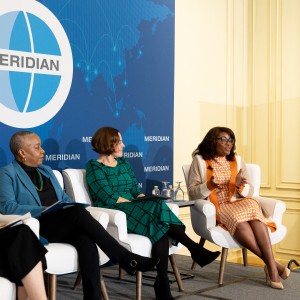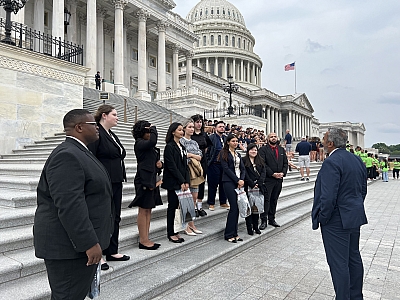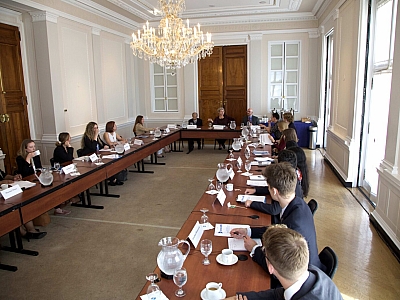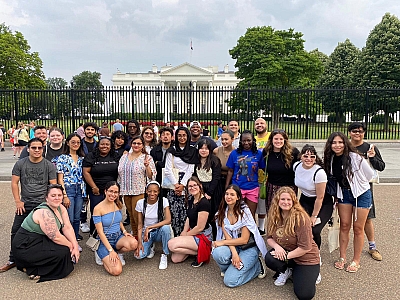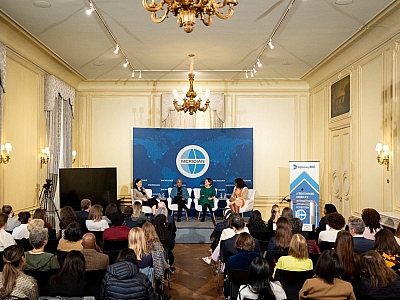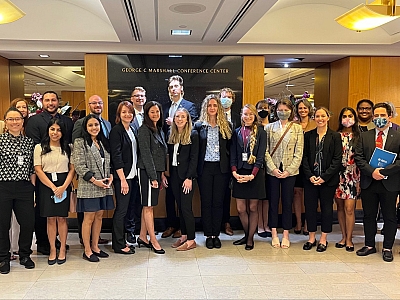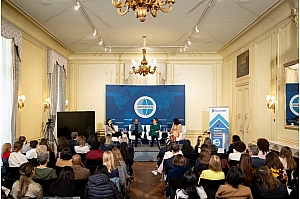Igniting the Week of Women and Girls

It is widely recognized that the full participation of women and girls in STEM (science, technology, engineering, and mathematics) is critical to the success of these disciplines. Yet, most countries are far from achieving gender equality in this area. According to UNESCO statistics, only 33.3% of researchers globally are women.
On February 5, 2024, Meridian partnered with the Women in Science Diplomacy Association (WiSDA) to launch their week of activities promoting the active and equal participation of women and girls in STEM globally. WiSDA was founded by the embassies of France, Italy, and Germany in Washington, DC in 2023. This DiplomacyRISE breakfast program celebrated WiSDA’s mission of advancing the role that women play in science and technology and encouraging greater global engagement of women in STEM through science diplomacy.
Featured speakers:
- Gloria Blackwell, CEO, AAUW
- Renee Wegrzyn, Ph.D. Director, ARPA-H
- Derya Büyüktanir Karacan, Ph.D. Visiting Scholar, The George Washington University
- Nikole Collins-Puri, Advisor, Techbridge Girls
- The Honorable Jennifer R. Littlejohn, Acting Assistant Secretary for Oceans and International Environment and Scientific Affairs, U.S. Department of State
- Victoria Molteni, Second Secretary, Embassy of Argentina
This event was made possible through the generous support of the Richard Lounsberry Foundation and the Gordon & Betty Moore Foundation.
Here are some top takeaways from the program:
1. Women in STEM at State
“It is in America’s interest, and everybody’s interest, to make sure that science is a community where men, women and people of all backgrounds can come together and contribute,” stated Acting Assistant Secretary J.R. Littlejohn. The State Department has committed to ensuring that women are well-represented in positions of leadership across STEM portfolios, and Littlejohn has been a champion of that commitment in her own bureau. This commitment has been shared across Federal agencies under the Biden-Harris Administration, which adopted the country’s first ever national strategy on gender equity and equality. In addition, the State Department has leveraged partnerships with non-governmental organizations to advance STEM engagement at home and abroad, including Meridian on the US Science Envoys Program (where six out of the seven envoys in the latest cohort were women). Internationally, the State Department has embarked on numerous projects to engage and educate female leaders in STEM, including a seed bank in Central America that provides training to local women and a $1.5 million dollar investment in careers in renewable energy in the Pacific Islands.
2. Metrics Matter
Gloria Blackwell, CEO at the American Association of University Women (AAUW), identified key metrics to assess the state of women in STEM. The first relates to graduation rates for women pursuing STEM degrees. In 2022, 50% of STEM graduates in bachelor’s degree programs in the United States were women; however, women only represent 35% of the STEM workforce. Retention rates can help understand this disparity, as Blackwell emphasized that, within 5-7 years of starting a career in STEM, 30% of women exit the profession due to institutionalized obstacles like lower pay and promotion rates. Blackwell also stressed the importance of tracking the current policy landscape, including legislation that is both advancing and inhibiting female engagement in STEM. Finally, we must look at salary and pay gap information. On average, men’s salaries are $15,000 greater than their female counterparts, and this gap is only more pronounced for Black women (where there is a $33,000 difference). “We hold our institutions accountable through these metrics,” asserted Blackwell.
3. Striving for Belonging, Not Representation
Nikole Collins-Puri, Advisor at Techbridge Girls, employed a recurring analogy throughout the panel discussion: checking a box versus reimagining the box. Representation in STEM means checking a box, she said. Belonging, on the other hand, requires reimagining the box. This means transforming the female experience in STEM across all of life’s stages: from early-childhood education to their time in the workforce. Renee Wegrzyn, Director at The Advanced Research Projects Agency for Health (ARPA-H), explored actions that organizations can take to advance belonging and center their operations around women. For instance, aside from elevating women to positions of leadership, ARPA-H ensures that its programs, ranging from clinical trials to product rollout and access, are designed around women’s health outcomes.
4. The Brilliance is Already in the Room
Knowingly or unknowingly, the people who exert the greatest influence on the next generation of leaders (including parents, caregivers, and educators) can act as gatekeepers to a meaningful future in STEM. “The brilliance is already in the room,” according to Collins-Puri, who believes strategic outreach to those adults can help them better encourage and uplift the girls in their lives. When asked by an audience member about the role of men as allies to women in the STEM workplace, Blackwell applied the same logic. Organizations need to implement workplace programs that help dismantle the implicit biases that lead men to perceive an intellectual deficit in their female co-workers. These biases perpetuate gender-based asymmetries in hiring processes, work assignments, and promotions.
5. Uncredited Contributors: Women in Science History
Acting Assistant Secretary Littlejohn pointed out that women have contributed to the advancement of science throughout all human history, despite not always receiving the credit they deserved. The contributions of BIPOC women have been neglected even more; when Tu Youyou won the Nobel Prize for Physiology or Medicine in 2015, she became the first non-white Nobel recipient in a STEM field. But by recognizing the contributions of women scientists of the past, we can uplift the women and girls that will design, discover, and cure the future. In our discussion, panelists celebrated the likes of Marie Curie, who in fact received a grant from the AAUW to pursue her research, Judith Resnick, Rachel Carson, Jedidah Isler, Gerty Cori, Emmanuelle Charpentier, Jennifer Doudna, Mae Jemison, and Grace Hopper. “I don’t want to invite these girls to something their ancestors built. They own it. So, give them the tools to own it,” said Collins-Puri considering this rich history. And as providers of those “tools,” the work of organizations like WiSDA, AAUW, and Techbridge Girls remains critical in ensuring that women and girls in STEM succeed—and, just as importantly, are recognized for those successes.
More DiplomacyRISE Programming
Project summary
| Igniting the Week of Women and Girls | February 2024 | |
|---|---|
| Impact Areas: | Empowering Women and Girls, Science and Technology |
| Program Areas: | Diplomatic Engagement |
| Partners: | Diplomatic Corps, Individuals/Donors, NGOs, Private Sector, Public Sector |
